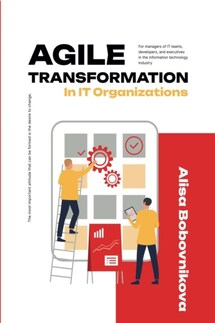Agile Transformation in IT-organizations - страница 4
It’s no secret that change is hard and can be difficult to be taken, especially with complex projects. Making even slight changes to existing systems can often feel laborious and not worth the effort. Studies show (Identifying the Reasons for Software Project Failure and Some of their Proposed Remedial through BRIDGE Process Models. INTERNATIONAL JOURNAL OF COMPUTER SCIENCES AND ENGINEERING. January, 2015, 3(1):118-126) that 60-80% of project failures can be caused by poor requirements gathering, analysis, and change management. The agile mindset is the best approach to variable and challenging environment as it offers an opportunity to embrace change, rather than continuously avoid it. It isn’t something that teams achieve, but rather something that is continuously cultivated. Developing teams should strive to optimize, solve problems, reflect, and continuously improve in the process.
Both Agile principles and values contain a very correct message, but they look quite abstract from the first sight. Agile methodology practices add to understanding of this approach. In order to investigate how Agile works, let's turn to the diagram and take a detailed look at the meaning of each link in Agile software development process:
LET'S SUMMARIZE WHAT WE’VE LEARNED IN THIS CHAPTER:
in brief, flexible methodology emergence was as natural as IT industry development. Deviation from out of time methods and software development flexibility request were influenced by huge expansion of the IT market and the subsequent demand for faster value to the consumer delivery.
Besides, now we know:
• Agile methodology started from 4 values which were followed by 12 principles;
• An iterative method of software development is in the base of agile approach;
• It gives developers an opportunity to deliver value to the consumer faster.
CHAPTER 2. WHAT ARE THE OTHER METHODOLOGIES? LET'S COMPARE WATERFALL AND AGILE
Let's see what approaches also exist in the world of software development besides the agile approach. First of all, this is the previously mentioned cascade methodology, also called "waterfall". We have already learned that in 1970 Dr. Winston Royce defined Waterfall methodology and suggested its basic principles:
• Program design comes first. Program designers work on the design of the system, not developers. Designers allocate e data processing models: database scheme, resources, some kind of non-functional requirements, interface, etc. Then an overview document must be prepared. The document should be understandable, informative, and current. Each team member must have an understanding of the system, and at least one person must have a deep understanding.
• Document the design. Some (in fact most) developers may wonder how much documentation is needed. Royce gives a simple answer: “Quite a lot”. Moreover, he says: “If the documentation is in serious default, my first recommendation is simple. Replace the project management. Stop all activities not related to documentation. Bring the documentation up to acceptable standards.”
Why documentation is important? Royce gives some points:
• documentation is a way of effective communication;
• during the early phase, the documentation is the specification and is the design;
• during the testing phase, the documentation can be considered as acceptance criteria;






